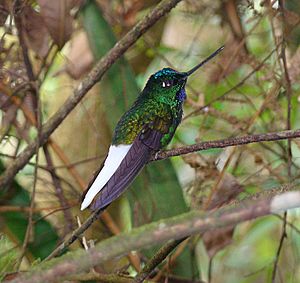White-tailed Starfrontlet facts for kids
Quick facts for kids White-Tailed Starfrontlet |
|
|---|---|
 |
|
| Conservation status | |
| Scientific classification | |
| Kingdom: | |
| Phylum: | |
| Class: | |
| Order: | |
| Family: | |
| Genus: |
Coeligena
|
| Species: |
C. phalerata
|
| Binomial name | |
| Coeligena phalerata Bangs, 1898
|
|
The White-Tailed Starfrontlet (Coeligena phalerata) is a special type of hummingbird. It lives only in the country of Colombia, which is in South America. These tiny birds make their homes in subtropical or tropical mountain forests where it's often moist and humid. They are known for their beautiful colors and, as their name suggests, a white tail!
Contents
About the White-Tailed Starfrontlet
The White-Tailed Starfrontlet is a small, colorful bird. It belongs to a group of hummingbirds called Coeligena, which are often called "starfrontlets" because of the bright, shiny feathers on their heads. These birds are very unique to the mountain regions of Colombia.
What Does It Look Like?
Male White-Tailed Starfrontlets are very striking. They have shiny green bodies and a bright, sparkling green or blue patch on their forehead, which looks like a star. Their most noticeable feature is their white tail, which stands out against their dark bodies. Females are usually a bit duller in color, but still very pretty. Both males and females have long, thin beaks, perfect for reaching nectar deep inside flowers.
Where Does It Live?
This hummingbird lives in the high mountain forests of Colombia. These areas are often called "cloud forests" because they are frequently covered in mist and clouds. The air is humid, and there are many different kinds of plants and flowers. These forests provide the perfect home for the White-Tailed Starfrontlet, offering plenty of food and shelter. They prefer areas between 1,800 and 3,000 meters (about 5,900 to 9,800 feet) above sea level.
What Does It Eat?
Like most hummingbirds, the White-Tailed Starfrontlet mainly eats nectar from flowers. Nectar is a sweet liquid that gives them lots of energy to fly. They use their long beaks and tongues to sip nectar from various flowering plants. They also eat small insects and spiders. These tiny creatures provide important protein that hummingbirds need to stay healthy. They often catch insects while flying, which is called "hawking."
Life Cycle and Reproduction
Hummingbirds are known for their amazing flight and unique ways of life. When it's time to have babies, the female White-Tailed Starfrontlet builds a tiny, cup-shaped nest. She often uses plant fibers, moss, and spider silk to make it strong and stretchy. She usually lays two small, white eggs. The mother bird does all the work of incubating the eggs and raising the chicks by herself. The father hummingbird does not help with the nest or the babies.
The chicks hatch after about 15 to 20 days. They are tiny and helpless. The mother feeds them a mix of nectar and insects. They grow very quickly and are ready to leave the nest in about three weeks.
Conservation Status
The White-Tailed Starfrontlet is currently listed as "Least Concern" by the International Union for Conservation of Nature (IUCN). This means that, for now, their population is stable and they are not considered to be in danger of extinction. However, like many forest animals, their habitat can be threatened by deforestation and climate change. Protecting their forest homes is important to make sure these beautiful birds continue to thrive.
See also
 In Spanish: Inca coliblanco para niños
In Spanish: Inca coliblanco para niños


